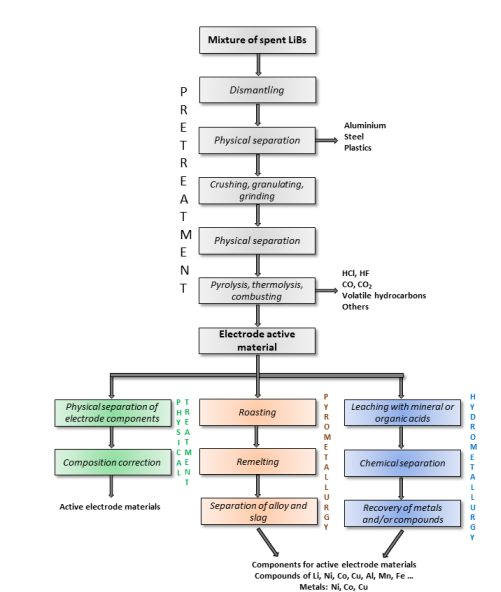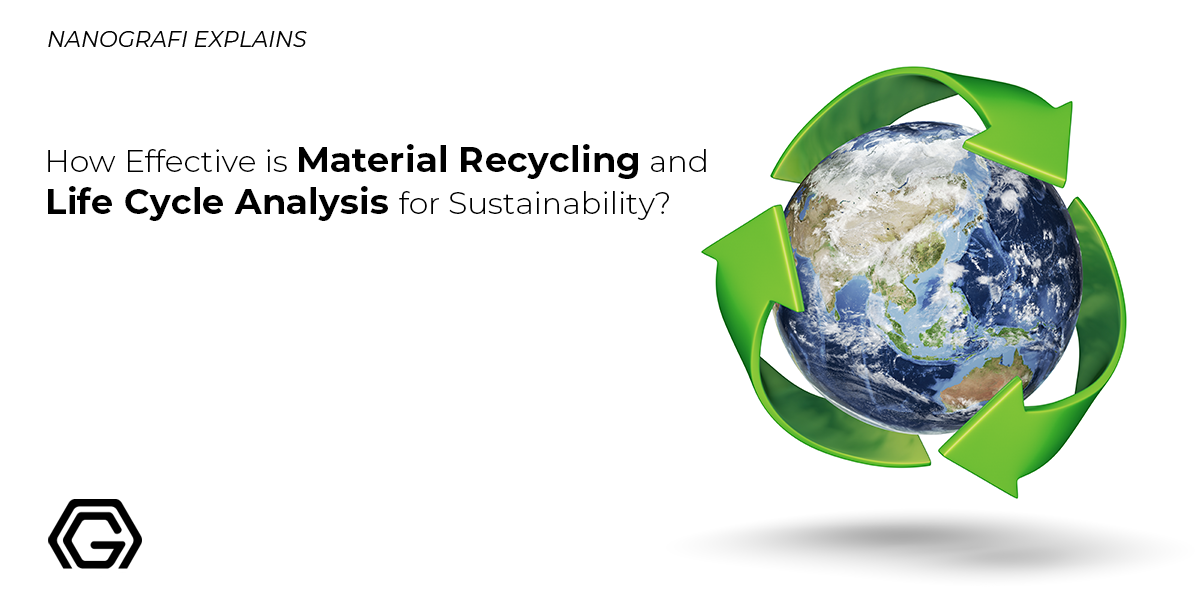How Effective is Material Recycling and Life Cycle Analysis for Sustainability?
Recycling has an important role in the context of waste management and resource efficiency and is a fundamental practice for environmental sustainability. Life cycle analysis (LCA) of materials enables the creation of sustainable production and consumption strategies by evaluating the environmental impacts of a product at all life cycle stages from raw material procurement to final processing.
In this study, the importance of recycling for waste management and resource efficiency will be emphasised. Life cycle analysis (LCA) of materials creates sustainable strategies by evaluating the environmental impacts of a product from raw material supply to final processing. Discover Nanografi's innovative solutions for sustainable nanotechnology products now.
Introduction
Today, environmental sustainability and resource efficiency are of great importance on a global scale. Increasing population, industrial production and consumption habits lead to rapid depletion of natural resources and increased environmental pollution. Recycling and life cycle analyses (LCA) of materials are important tools to overcome these problems.
Why Recycling is Important?
Recycling makes tangible contributions to reducing the consumption of natural resources, saving energy and reducing greenhouse gas emissions. For example, according to the European Environment Agency (EEA), metal and plastic recycling can reduce energy consumption by 30 to 90 per cent and greenhouse gas emissions by 50 to 80 per cent. In addition, US Environmental Protection Agency (EPA) reports show that paper recycling prevents greenhouse gas emissions equivalent to approximately 1.3 tonnes of carbon dioxide per tonne. These data quantitatively demonstrate the contribution of recycling to environmental sustainability.
Life Cycle Analysis (LCA)
Life cycle analysis (LCA) is a methodology that comprehensively assesses the environmental impacts of a product or service. This analysis covers all stages of a product from the extraction of its raw materials to its production, use and final disposal. LCA is one of the most powerful tools used to identify and reduce environmental impacts.
LCA consists of four main stages;
Goal and Scope Determination: At this stage, the purpose and scope of the study are determined. The product system, functional unit and boundaries to be analysed are defined. This clarifies the purpose of the study and which environmental impacts will be assessed.
Inventory Analysis: Inventory analysis creates a comprehensive inventory of the materials and energy used throughout the product life cycle, as well as the resulting emissions and waste. This stage details the relationships between processes and data collection methods.
Impact Assessment: Impact assessment is the process of translating the data collected in the inventory analysis into environmental impacts. At this stage, various environmental impact categories such as global warming, ozone layer destruction, acid rain, ecotoxicity are analysed. These categories form the environmental profile of the product.
Interpretation: The final stage, interpretation, is to analyse the results obtained and provide guiding recommendations to decision makers. At this stage, uncertainties and data gaps in the analysis process are also addressed.
Application Areas of LCA
Life Cycle Analysis (LCA) has a wide range of applications and is used to assess environmental performance in various industries. Key application areas of LCA include sustainable product design, policy development, corporate sustainability reporting, environmental management strategies and supply chain management.
Sustainable Product Design
LCA is used at the design stage to minimise the environmental impact of products. This approach aims to optimise energy and material consumption at all stages of the product life cycle. For example, graphene materials are used in electronics and energy storage devices with their high mechanical and electrical properties. Analysing the production processes of these materials with LCA contributes to the development of more sustainable production methods.
Policy Development
LCA is a critical tool in the formulation and improvement of environmental policies. The European Union uses LCA methodology to assess the environmental performance of products under the Ecodesign Directive. This directive aims to improve the energy efficiency of products and reduce their environmental impact. In addition, LCA results are used in carbon footprint calculations and national greenhouse gas inventories.
Advanced materials such as nanocomposites offer the advantages of high durability and low weight in the construction industry. By assessing the environmental impact of these materials, LCA enables the development of more sustainable building materials.
Corporate Sustainability Reporting
Many companies assess and improve their environmental performance by using LCA data in their sustainability reports. For example, a technology company can develop more sustainable products and document its environmental responsibilities by analysing the environmental impacts of all processes from the production to disposal of electronic devices.
Environmental Management Strategies
LCA plays an important role in the development and implementation of environmental management strategies. Companies can develop strategies based on LCA results to reduce the environmental impacts of their production processes. These strategies can cover topics such as waste management, energy efficiency, water use and emission reduction. For example, nanocoatings play an important role in protecting surfaces and improving energy efficiency. Analysing the production processes of these coatings with LCA helps to optimise environmental performance.
Recycling and LCA
The relationship between recycling and life cycle analysis (LCA) is critical in developing and improving environmental sustainability strategies. LCA is a tool used to comprehensively assess the environmental impacts of recycling processes and these assessments help to develop more sustainable practices.
Impact of Recycling on LCA
Recycling is an effective way to reduce the environmental impact of products throughout their life cycle. LCA methodology makes it possible to assess the reduction in energy consumption, greenhouse gas emissions and raw material utilisation of recycling processes, as well as other environmental impacts of these processes. For example, metal recycling reduces energy consumption by 60-90 per cent and significantly reduces greenhouse gas emissions. Such data tangibly demonstrates the environmental benefits of recycling and quantifying these benefits through LCA provides important guidance for policy makers and industry.
LCA and Optimisation of Recycling Strategies
LCA is used to evaluate and optimise the effectiveness of recycling strategies. For example, in one study, LCA of construction and demolition waste recycling showed that 100 per cent recycling of materials such as metal, plastic and glass resulted in both environmental and economic savings. The same study indicated that recycling asphalt and concrete increases the environmental footprint due to high fuel consumption and emissions. Such analyses allow the necessary adjustments to be made to make recycling strategies more sustainable.
Latest Technologies in LCA and Recycling
Recycling of Lithium-Ion Batteries: Recycling of lithium-ion batteries has gained great importance especially with the widespread use of electric vehicles. Pyro- and hydrometallurgical methods are widely used in the recycling of these batteries. Pyrometallurgy involves the processing of batteries at high temperatures, while hydrometallurgy enables the separation of metals using solution. These methods make it possible to recover precious metals such as lithium and cobalt.

Figure 1. Diagram showing battery recycling methods.
Recycling of Plastic Wastes: Mechanical and chemical recycling methods are used in the recycling of plastic wastes. While mechanical recycling involves the physical processing of plastics, chemical recycling enables the separation of plastics at the molecular level. These processes are effective in reducing greenhouse gas emissions and resource depletion throughout the life cycle of plastics. However, as mechanical recycling has the potential to increase microplastic pollution, chemical recycling needs to be improved.
Integrated Assessment Models: LCA is a tool used to comprehensively assess the environmental impacts of various processes. In recent years, LCA models have been integrated to provide more comprehensive and detailed analyses. For example, LCA studies on construction waste recycling use integrated models to compare the impacts of different waste management options on global warming potential.
Advanced Software and Databases: Software and databases used in LCA analyses are continuously updated and improved. These tools provide more accurate and reliable results. For example, LCA software such as SimaPro and GaBi allow users to analyse complex data sets and model environmental impacts.
Dynamic LCA Approaches: The static nature of traditional LCA approaches can lead to an inability to fully assess environmental impacts that change over time. Dynamic LCA approaches provide more accurate results by taking into account processes and impacts that change over time. This approach is especially critical in long-term projects and in the development of sustainability strategies.
Nanofiltration Membranes: Nanofiltration membranes developed with nanotechnology are used in water treatment and recycling processes. These membranes provide clean water by effectively separating pollutants and heavy metals in water. This technology plays an important role especially in industrial water recycling and wastewater treatment.
Nanocatalysts: Nanocatalysts are nanotechnological materials used to increase the efficiency of chemical reactions. These catalysts are used in the chemical recycling of plastics and other organic wastes. Nanocatalysts optimise recycling processes by providing lower energy consumption and higher conversion rates.
Nanocomposites: Nanocomposites can be used to improve the mechanical and thermal properties of recycled materials. These materials enhance the properties of recycled plastics and metals for use in the construction and automotive sectors. Nanocomposites contribute to environmental sustainability by extending the useful life of recycled materials.
Conclusion
Recycling is an indispensable tool to ensure environmental sustainability in the context of waste management and resource efficiency. Life cycle analysis (LCA) of materials plays an important role in establishing sustainable production and consumption strategies by assessing the environmental impacts of recycling processes. Recycling provides tangible environmental benefits such as energy savings and reduction of greenhouse gas emissions. LCA methodology enables these benefits to be quantified and optimised.
Minimising environmental impacts throughout the life cycle of products is a critical step in building a more sustainable future. Technological advances make significant contributions to achieving sustainability goals. Minimising environmental impacts while increasing resource efficiency contributes to a sustainable future.To achieve environmental sustainability goals, recycling and LCA need to be integrated and these processes need to be continuously improved.
To follow the latest developments and innovations related to nanotechnology, visit Blografi.
References
European Environment Agency. (2020). Waste recycling and recovery. Retrieved from https://www.eea.europa.eu/en/topics/in-depth/waste-and-recycling
U.S. Environmental Protection Agency. (2021). Paper recycling and its environmental impact. Retrieved from https://archive.epa.gov/wastes/conserve/materials/paper/web/html/index-2.html#industry
Curran, M. A. (2012). Life Cycle Assessment Handbook: A Guide for Environmentally Sustainable Products. John Wiley & Sons.
Guinée, J. B., Heijungs, R., Huppes, G., Zamagni, A., Masoni, P., Buonamici, R., Ekvall, T., & Rydberg, T. (2011). Life cycle assessment: Past, present, and future. Environmental Science & Technology, 45(1), 90-96. https://doi.org/10.1021/es101316v
Pehnt, M. (2006). Dynamic life cycle assessment (LCA) of renewable energy technologies. Renewable Energy, 31(1), 55-71. https://doi.org/10.1016/j.renene.2005.03.002
Recent Posts
-
Turning Noise into Power: Energy Harvesting with Piezoelectric Nanogenerators
Ambient acoustic energy, once an untapped resource, is now being converted into sustainable electric …5th Mar 2025 -
Holey Super Graphene in Li-ion Batteries: Next Generation of Energy Storage
Holey Super Graphene (hG), also referred to as “holey graphene,” is redefining li-ion ba …7th Feb 2025 -
Future Communication with 5G Technology and Advanced Materials
5G technology opens the doors to a new era in communication with faster connection speeds, low laten …6th Feb 2025





